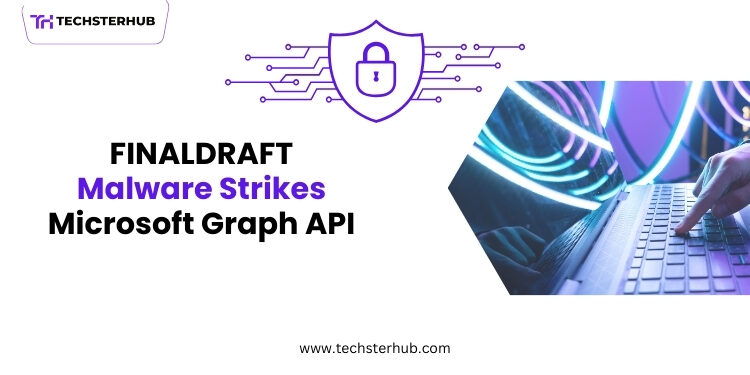The cybersecurity industry is facing a new challenge with the emergence of a malware named FINALDRAFT. The malware exploits Microsoft’s Graph API to conduct espionage and extract sensitive data from both Windows and Linux systems. The attack becomes a substantial security threat through its ability to target multiple operating systems and its innovative approach to sidestep conventional security systems. We need to study FINALDRAFT malware to understand its functionality and recognize the security risks it presents to users on a global scale.
What is FINALDRAFT Malware?
FINALDRAFT functions as a complex spyware tool developed to monitor both people and organizations. The main purpose of this threat is to access computer systems and steal sensitive information while maintaining ongoing control of the targeted device. The malware poses a high threat level because it utilizes Microsoft’s Graph API which enables developers to retrieve data from Microsoft 365 and OneDrive services.
In early 2025 cybersecurity experts first identified the malware during a standard security evaluation. FINALDRAFT malware stands out from other malware because its stealth operation allows it to evade detection by standard antivirus programs.
How Does FINALDRAFT Malware Work?
FINALDRAFT malware communicates with Microsoft’s cloud services through the Microsoft Graph API. The Graph API serves as an application interface for accessing multiple Microsoft services including emails and calendars and managing files among other functions. The exploitation of this API lets FINALDRAFT retrieve sensitive cloud-stored data while remaining undetected by both users and system administrators.
Here’s how the malware typically works:
- Infection: FINALDRAFT usually enters systems by sending users phishing emails and directing them to malicious websites. When users activate a harmful link or attachment, they encounter the malware downloads and installs onto their device.
- Using the Graph API: Once FINALDRAFT has been installed, it connects to Microsoft’s Graph API. The malware accesses Microsoft’s Graph API to steal private emails and cloud-stored documents without permission. The malware reaches its peak efficiency in this stage because it gains access to important files located in services like OneDrive and Microsoft Teams.
- Espionage: The malware operates in stealth mode while gathering system-sensitive data. The malware targets confidential emails along with documents and passwords among other sensitive materials. The attacker takes advantage of this stolen data to conduct identity theft or corporate espionage while also potentially using it for blackmail.
- Persistence: FINALDRAFT operates with the specific purpose of staying hidden from detection systems for the maximum possible time. The malware conceals itself within the infected system which prevents detection by both users and security programs. Through its persistent nature FINALDRAFT allows attackers to maintain system access for victims across extended durations.
Why is FINALDRAFT So Dangerous?
FINALDRAFT presents a significant danger to both personal users and business organizations due to multiple factors.
- Cross-Platform Threat: FINALDRAFT stands out because it can infect both Windows and Linux operating systems. FINALDRAFT malware stands out because it targets both Windows and Linux operating systems while most other malware typically targets only one platform. The software’s ability to target both Windows and Linux users enables it to compromise users from individual people to major organizations operating on both platforms.
- Use of Microsoft Graph API: FINALDRAFT malware stands out from other malware because it uses the Microsoft Graph API as one of its fundamental features. The malware operates through a Microsoft-provided legitimate API thereby avoiding initial detection from antivirus software. FINALDRAFT proves to be an effective espionage tool because numerous organizations depend on Microsoft’s cloud services to store their sensitive data.
- Espionage Capabilities: FINALDRAFT is specifically designed for espionage. The malware quietly collects sensitive data which criminals use to carry out identity theft, extortion, and espionage against companies. Attackers who seek to steal critical data can leverage this malware because it collects emails, documents, and login credentials.
- Difficult to Detect: FINALDRAFT uses techniques to prevent antivirus programs from identifying it. Antivirus software relies on signature-based detection to identify malware but FINALDRAFT evades detection because it operates just like legitimate services. Traditional security software faces more difficulty detecting this infection because of its design.
Who is At Risk?
Users of Microsoft applications including Office 365, OneDrive, and Teams face potential threats from FINALDRAFT. This includes both individuals and businesses. The malware poses a significant threat to organizations that keep sensitive information in the cloud since it can extract valuable business data without detection.
Some specific groups at risk include:
- Employees who work for companies that depend on Microsoft products for communication and file storage become prime targets. When malware successfully extracts company secrets as well as intellectual property and confidential client data it brings about significant financial losses and damages to the organization’s reputation.
- Government Agencies: Espionage against government organizations using FINALDRAFT could result in classified or sensitive information theft that impacts national security.
- General Users: The same malware could affect anyone who stores personal documents and photos in Microsoft cloud services. Identity thieves and malicious actors could exploit the stolen data for harmful activities.
How to Protect Yourself from FINALDRAFT Malware
Despite FINALDRAFT being a complex and stealthy threat users can implement multiple protective strategies to secure their systems and information against this malware.
- Be Cautious with Emails: Open emails from unknown senders only after thorough verification. The primary delivery method for the FINALDRAFT malware to systems is through phishing attacks. Do not click on links nor download attachments from emails which appear suspicious.
- Use Antivirus Software: Use a reputable antivirus program which should be installed and kept up-to-date for malware detection and removal. FINALDRAFT has the potential to evade certain security defense but modern antivirus programs typically contain mechanisms to detect atypical system activities.
- Enable Two-Factor Authentication (2FA): Enable 2FA on your Microsoft accounts. Two-Factor Authentication (2FA) enhances security by making it more difficult for attackers to access your data even when they have your login credentials.
- Keep Software Updated: Always update both your operating system and applications to maintain security. Security patches from developers target vulnerabilities which malware such as FINALDRAFT could use to compromise systems.
- Educate Yourself and Others: Keep yourself updated about current cybersecurity threats and teach your family members, friends, and work associates how to identify potential phishing attacks along with other dangerous risks.
Conclusion
The new cybersecurity threat FINALDRAFT exploits Microsoft’s Graph API to execute espionage operations across both Windows and Linux operating systems. Attackers find FINALDRAFT particularly useful because it steals sensitive data without being detected. Understanding FINALDRAFT’s operational methods and implementing preventive actions helps protect individuals and organizations from this hazardous malware. To defend against this type of attack you must remain vigilant and practice strong security measures while updating your software regularly.











